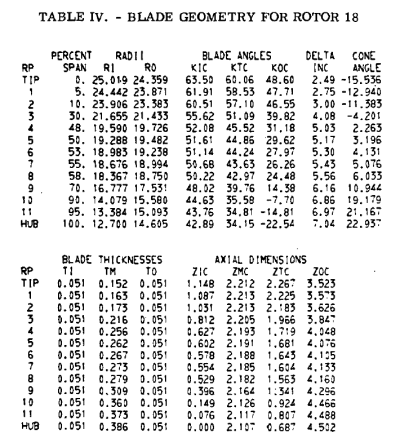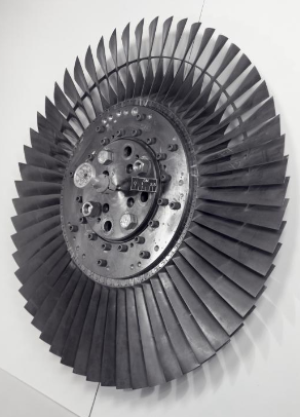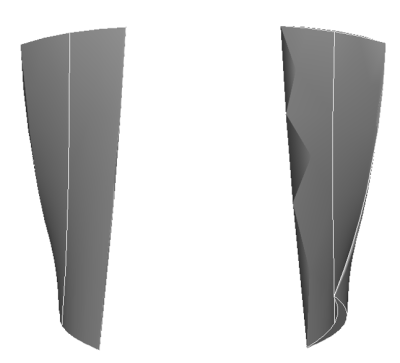Ceci est une ancienne révision du document !
Rotor 18
Original model
One way to reduce compressor weight is to obtain a high pressure ratio per stage, thereby reducing the number of stages. As a consequence, several single-stage fans have been designed to produce stage pressure ratios ranging from 1.9 to 2.2. Rotor 18 is one of those fans with a pressure ratio of 1.925.
- Original technical report [1]:
@TechReport{lewis1974design, author = {Lewis, George W. and Reid, Lonnie and Tysl, Edward R.}, title = {Design and performance of a high-pressure-ratio, highly loaded axial-flow transonic compressor stage}, institution = {NASA Lewis Research Center Cleveland, OH, United States}, note = {NASA-TM X-3100, url~: \url{https://ntrs.nasa.gov/citations/19740025108}, 1974}} - Picture :
@Misc{huebler1974records,
author = {Huebler, D.},
title = {Rotor 18. {R}ecords of the {N}ational {A}eronautics and {S}pace {A}dministration, 1903 - 2006. {P}hotographs relating to agency activities, facilities and personnel, 1973 - 2013},
note = {\href{https://catalog.archives.gov/id/17422714}{https://catalog.archives.gov/id/17422714}, 1974 }, % for Fig. 1}
Useful documents
- PDF of the NASA report : rotor18.pdf
- CSV file of the blade geometry : rotor18_original.csv
Geometry
The geometry of rotor 18 is described in the original NASA report by the following tables. The length are in centimeters and the angles in degrees.

Aerodynamic design
| unit | values | |
|---|---|---|
| pressure ratio | [-] | 1.925 |
| mass flow | [kg/s] | 29.5 |
| tip speed | [m/s] | 422 |
| tip solidity | [-] | 1.7 |
| aspect ratio | [-] | 2.6 |
| number of blades | [-] | 56 |
| rotative speed | [rad/s] | 1686 |
Material properties
The original material of the rotor 18 is not defined in the NASA report.
Considered properties: Ti-6Al-4V, generic titanium :
| unité | valeurs | |
|---|---|---|
| alloy | [-] | Ti-6Al-4V |
| Young's modulus | [GPa] | 108 |
| density | [kg/m3] | 4400 |
| Poisson's ratio | [-] | 0.34 |
| yield stress | [GPa] | 0.824 |
First three natural frequencies (with clamped root) for the mesh:
- (1B): 2040.6 rad/s / 324.8 Hz
- (2B): 6744.2 rad/s / 1073.4 Hz
- (1T): 10769.2 rad/s / 1714.0 Hz
CAD
Modèle original
Une façon de réduire le poids d’un compresseur est d’atteindre un rapport de pression élevé par étage, ce qui permet de réduire le nombre d'étages de ce compresseur. Par conséquent, plusieurs soufflantes à un étage ont été conçus pour produire des rapports de pression par étage allant de 1,9 à 2,2. Le rotor 18 est donc une de ces soufflantes et possède un taux de compression de 1,925.
- Rapport technique original [1]:
@TechReport{lewis1974design, author = {Lewis, George W. and Reid, Lonnie and Tysl, Edward R.}, title = {Design and performance of a high-pressure-ratio, highly loaded axial-flow transonic compressor stage}, institution = {NASA Lewis Research Center Cleveland, OH, United States}, note = {NASA-TM X-3100, url~: \url{https://ntrs.nasa.gov/citations/19740025108}, 1974}} - Photographie :
@Misc{huebler1974records,
author = {Huebler, D.},
title = {Rotor 18. {R}ecords of the {N}ational {A}eronautics and {S}pace {A}dministration, 1903 - 2006. {P}hotographs relating to agency activities, facilities and personnel, 1973 - 2013},
note = {\href{https://catalog.archives.gov/id/17422714}{https://catalog.archives.gov/id/17422714}, 1974 }, % for Fig. 1}
Documents utiles
- PDF du rapport de la NASA : rotor18.pdf
- Fichier CSV de la géométrie : rotor18_original.csv
Géométrie
La géométrie du rotor 18 est décrite dans le rapport d'origine de la NASA par les tableaux suivants. Les grandeurs sont en centimètres et en degrés.
Caractéristiques aérodynamiques
| unités | valeurs | |
|---|---|---|
| taux de compression | [-] | 1,925 |
| débit massique | [kg/s] | 29,5 |
| vitesse en tête | [m/s] | 422 |
| solidité en tête | [-] | 1,7 |
| allongement | [-] | 2,6 |
| nombre d'aubes | [-] | 56 |
| vitesse de rotation | [rad/s] | 1686 |
Propriétés matériau
Le matériau original du rotor 18 n'est pas défini dans le rapport de la NASA.
Propriétés considérées : alliage de titane Ti-6Al-4v :
| unité | valeurs | |
|---|---|---|
| alliage | [-] | Ti-6Al-4v |
| module d'Young | [GPa] | 108 |
| masse volumique | [kg/m3] | 4400 |
| coefficient de Poisson | [-] | 0,34 |
| limite élastique | [GPa] | 0,824 |
Fréquences des trois premiers modes (noeuds de la base encastrés) pour le maillage :
- (1B): 2040,6 rad/s / 324,8 Hz
- (2B): 6744,2 rad/s / 1073,4 Hz
- (1T): 10769,2 rad/s / 1714,0 Hz

